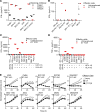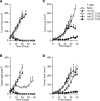Engineered T cells targeting E7 mediate regression of human papillomavirus cancers in a murine model
- PMID: 29669936
- PMCID: PMC5931134
- DOI: 10.1172/jci.insight.99488
Engineered T cells targeting E7 mediate regression of human papillomavirus cancers in a murine model
Abstract
T cell receptor (TCR) T cell therapy is a promising cancer treatment modality. However, its successful development for epithelial cancers may depend on the identification of high-avidity TCRs directed against tumor-restricted target antigens. The human papillomavirus (HPV) E7 antigen is an attractive therapeutic target that is constitutively expressed by HPV+ cancers but not by healthy tissues. It is unknown if genetically engineered TCR T cells that target E7 can mediate regression of HPV+ cancers. We identified an HPV-16 E7-specific, HLA-A*02:01-restricted TCR from a uterine cervix biopsy from a woman with cervical intraepithelial neoplasia. This TCR demonstrated high functional avidity, with CD8 coreceptor-independent tumor targeting. Human T cells transduced to express the TCR specifically recognized and killed HPV-16+ cervical and oropharyngeal cancer cell lines and mediated regression of established HPV-16+ human cervical cancer tumors in a mouse model. These findings support the therapeutic potential of this approach and established the basis for an E7 TCR gene therapy clinical trial in patients with metastatic HPV+ cancers (NCT02858310).
Keywords: Immunology; Immunotherapy; T cells; T-cell receptor.
Conflict of interest statement
Figures





References
Publication types
MeSH terms
Substances
Associated data
LinkOut - more resources
Full Text Sources
Other Literature Sources
Medical
Molecular Biology Databases
Research Materials

